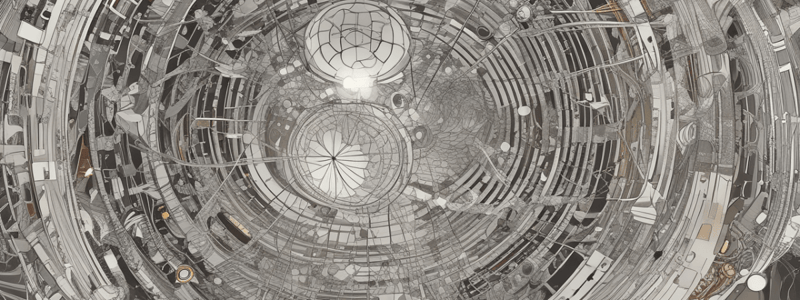Podcast
Questions and Answers
What is the main objective of the P-System in the Theory of Constraints?
What is the main objective of the P-System in the Theory of Constraints?
- To manage queues of work-in-progress
- To reduce inventory levels
- To optimize manufacturing resource planning
- To synchronize the entire production process with the bottleneck (correct)
What is the primary goal of the Q-System?
What is the primary goal of the Q-System?
- To reduce manufacturing lead times
- To identify and address constraints
- To manage and control queues of work-in-progress (correct)
- To increase inventory levels
What is the main benefit of using Materials Requirement Planning (MRP)?
What is the main benefit of using Materials Requirement Planning (MRP)?
- Reduced manufacturing lead times
- Increased inventory levels
- Improved production efficiency (correct)
- All of the above
What is the main purpose of Manufacturing Resource Planning (MRP-II)?
What is the main purpose of Manufacturing Resource Planning (MRP-II)?
What is the main objective of using the P-System and Q-System together?
What is the main objective of using the P-System and Q-System together?
What is the main benefit of using MRP in production planning?
What is the main benefit of using MRP in production planning?
What is the main goal of the Q-System in managing work-in-progress?
What is the main goal of the Q-System in managing work-in-progress?
What is the main function of MRP in managing production?
What is the main function of MRP in managing production?
What is the main advantage of using the TOC methodology?
What is the main advantage of using the TOC methodology?
What is the main objective of inventory reduction in MRP?
What is the main objective of inventory reduction in MRP?
What is the primary objective of Just-In-Time (JIT) inventory management method?
What is the primary objective of Just-In-Time (JIT) inventory management method?
What is the consequence of overproduction in a supply chain?
What is the consequence of overproduction in a supply chain?
What is the benefit of using a Just-In-Time inventory management system?
What is the benefit of using a Just-In-Time inventory management system?
What is the primary function of an Enterprise Resource Planning (ERP) system?
What is the primary function of an Enterprise Resource Planning (ERP) system?
What is the outcome of implementing an ERP system in an organization?
What is the outcome of implementing an ERP system in an organization?
What is the scope of an ERP solution?
What is the scope of an ERP solution?
What is the benefit of using an ERP system in a multi-plant, multi-location global operation?
What is the benefit of using an ERP system in a multi-plant, multi-location global operation?
What is included in ERP business activities?
What is included in ERP business activities?
What is the role of ERP in managing organizational information flows?
What is the role of ERP in managing organizational information flows?
What is the outcome of ERP introduction on line managers?
What is the outcome of ERP introduction on line managers?
What is the primary assumption in a certainty case of a dynamic model?
What is the primary assumption in a certainty case of a dynamic model?
What is the primary limitation of certainty in dynamic models?
What is the primary limitation of certainty in dynamic models?
Which of the following is a characteristic of a certainty case in a dynamic model?
Which of the following is a characteristic of a certainty case in a dynamic model?
What can be predicted accurately in a certainty case of a dynamic model?
What can be predicted accurately in a certainty case of a dynamic model?
What is the Economic Production Quantity (EPQ) model designed for?
What is the Economic Production Quantity (EPQ) model designed for?
What is the key objective of the P-System in production planning and control?
What is the key objective of the P-System in production planning and control?
What is the environment like in a certainty case of a dynamic model?
What is the environment like in a certainty case of a dynamic model?
What characteristic of risk in production planning is related to market conditions, supply chain disruptions, and technology failures?
What characteristic of risk in production planning is related to market conditions, supply chain disruptions, and technology failures?
What is the nature of the relationships between variables in a certainty case of a dynamic model?
What is the nature of the relationships between variables in a certainty case of a dynamic model?
What can be confidently predicted in a certainty case of a dynamic model?
What can be confidently predicted in a certainty case of a dynamic model?
What is the primary difference between the EPQ model and the EOQ model?
What is the primary difference between the EPQ model and the EOQ model?
What is the assumption about the model parameters in a certainty case of a dynamic model?
What is the assumption about the model parameters in a certainty case of a dynamic model?
What is the purpose of assessing and addressing uncertainties in a dynamic model?
What is the purpose of assessing and addressing uncertainties in a dynamic model?
What is the primary focus of the Q-System in production planning and control?
What is the primary focus of the Q-System in production planning and control?
What is the characteristic of a system in a certainty case of a dynamic model?
What is the characteristic of a system in a certainty case of a dynamic model?
What is the key difference between a certainty case and an uncertainty case of a dynamic model?
What is the key difference between a certainty case and an uncertainty case of a dynamic model?
What is the significance of the holding cost in the EPQ model?
What is the significance of the holding cost in the EPQ model?
What is the significance of considering both certainty and uncertainty cases in dynamic modeling?
What is the significance of considering both certainty and uncertainty cases in dynamic modeling?
What is the main characteristic of a risk case in a dynamic model?
What is the main characteristic of a risk case in a dynamic model?
What is the primary goal of the Theory of Constraints (TOC) in production planning and control?
What is the primary goal of the Theory of Constraints (TOC) in production planning and control?
Flashcards are hidden until you start studying
Study Notes
Dynamic Model
- A dynamic model represents systems that change over time
- Certainty case in a dynamic model:
- All variables and parameters are known with absolute precision
- No ambiguity or variability in the system
- Predictable changes and no external shocks
- Deterministic relationships between variables
- Limitations of certainty in dynamic models:
- Overly simplifies real-world conditions
- Fails to account for uncertainties, variability, and dynamic nature of the external environment
Optimum Lot Size Model with Constant Demand (EPQ Model)
- Deals with constant demand scenarios and is a dynamic lot-sizing model
- Key components:
- Demand Rate (D)
- Production Rate (P)
- Setup (or Ordering) Cost (S)
- Holding (or Carrying) Cost (H)
- Shortage Cost (if applicable)
Risk Case in Dynamic Model
- Involves assessing and addressing uncertainties that may impact the model's behavior, outcomes, or predictions
- Characteristics of risk in production planning and control:
- Uncertainty
- Variability
- Complexity
- Interdependence
- Time sensitivity
P-System and Q-System
- Part of the Theory of Constraints (TOC), a management philosophy
- P-System:
- Focuses on maximizing productivity and efficiency of the production process
- Identifies and eliminates bottlenecks or constraints
- Emphasizes synchronizing the entire production process with the bottleneck
- Q-System:
- Manages and controls queues of work-in-progress (WIP) that accumulate in front of bottlenecks
- Manages the flow of work through the system
- Balances WIP levels to keep the bottleneck working continuously without overwhelming downstream processes
Material Requirement Planning (MRP)
- Basic calculations to determine components required from end item requirements
- Objectives:
- Inventory reduction
- Reduction in manufacturing and delivery lead times
- Realistic delivery commitments
- Increased efficiency
- MRP is a methodology used for planning and managing manufacturing operations
- Involves the use of software to assist with planning and scheduling of production processes
Just-In-Time (JIT)
- Inventory management method where goods are received from suppliers only as they are needed
- Reduces inventory holding costs and increases inventory turnover
- Importance of JIT:
- Reduces inventory waste
- Decreases warehouse holding costs
Enterprise Resource Planning (ERP)
- Complex information system that incorporates both internal and external information flows
- Need for ERP:
- Incorporates all business functions and external stakeholders
- Objectives of ERP:
- Drives the flow of information between all internal business functions
- Manages functions related to outside stakeholders
- ERP solutions:
- Address organizational needs, not selected islands of the organization
- Bring new culture, cohesion, and vigor to the organization
- Guarantee benefits even if the organization is a multi-plant, multi-location global operation
Studying That Suits You
Use AI to generate personalized quizzes and flashcards to suit your learning preferences.





